Nimble irrigation answers winemaker’s calls as superb quality meets the growing needs for long-term sustainability
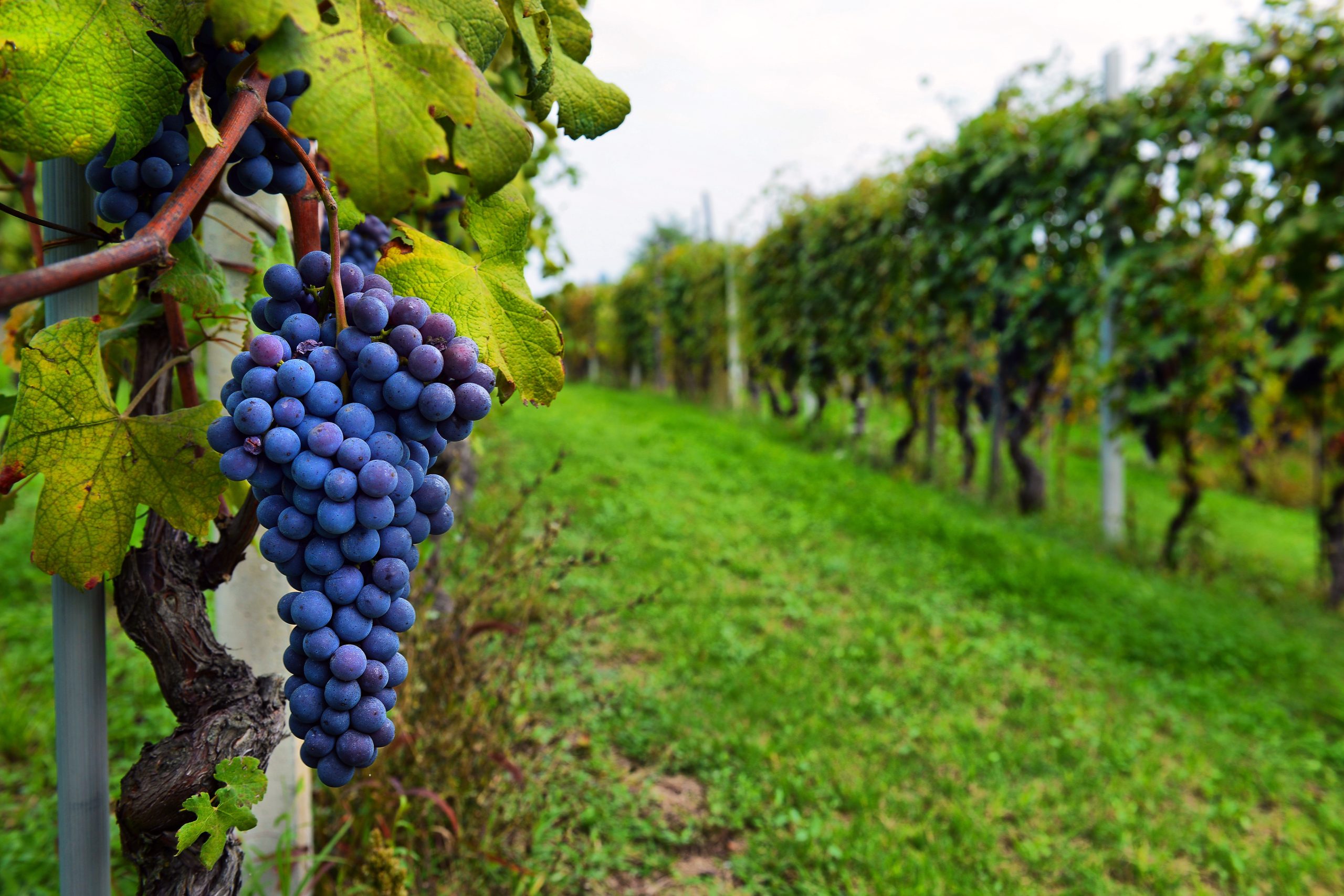

Australia burst onto the world wine scene from the 1980s, at the start of which domestic consumption was under three litres per capita and exports were paltry compared with the quality on offer.
Fast forward to 2023 and domestic consumption is six times what it was, and exports total more than 621 million litres, according to Wine Australia, the statutory body established in recognition of the industry’s importance.
Australia now ranks as high as fifth in the world as an exporter, behind Italy, Spain, France, and Chile. And despite now being classified as a mature industry, selling mostly into mature markets, such as the UK and the US, the push is on to recapture lost ground in China and open up new growth markets in South-East Asia.
Tapping into these markets with volume and price growth potential is doubly important given the declining returns in major markets such as the UK and USA, where Wine Australia notes both values and volume are down post-Covid, with the main driver being structural decline in US lower price segments, where Australian wine is predominantly sold.
“Advances in price, productivity, quality, and volume are crucial across Australia’s 65 wine regions, well over 2,000 wineries, and approximately 6,000 grape growers in an industry contributing over $45 billion annually to the Australian economy,” according to Wine Australia report summary 2021- 2022.
Challenge to boosting wine volume
The challenge to boost volume and quality is a major one both in South Australia and nationally, when you consider that:
- Of the estimated 160,000 people employed full and part-time in the wine industry, most are based in rural and regional areas where the industry is vital on a broad national economic base.
- The economic viability and prosperity of many wine-growing areas is crucially dependent on best-practice irrigation tailored for particular regions, given that the World Bank says irrigated agriculture represents 20 percent of the planet’s total cultivated land and contributes 40 percent of the total food produced worldwide. Irrigation is a critical input for agricultural production, and plays an important role in food security in Australia and abroad.
- And with the arrival in Australia of a typically drier El Nino weather pattern, the need today is even greater to efficiently use the shared community resources of bore water and river water.
The importance of irrigation
The need for efficient irrigation practices – particularly those boosting the output and quality of high-value grapes – is important not only for a business’ social licence to operate, and its ability to support local jobs, but also to adapt to changes on a local level.
“The Australian Grape and Wine sector’s Vision 2050 lays out the steps needed to craft a prosperous and self-reliant sector into the future. It provides responses to growing international concerns around climate change, sustainable development, and international stability,” says South Australian irrigation specialist Lindsay Thompson, from the national Water Dynamics irrigation network.
Viticulturist and Wine industry quality leaders also recognise that not only do new irrigation installations need to perform to their optimum, but also existing systems need to be updated to get the best from them, he says.
This isn’t only a matter of getting the best performance in terms of water conservation and use, but also how the water is applied to get the best cropping for the best grapes by applying exactly the right amount of water at the right time.
The right time can vary according to factors such as their growth patterns, soil conditions, varying weather conditions and a host of factors that vary from vineyard to vineyard, district to district and State to State.
“One size does not fit all – and what was good 30 years ago, can be less ideal today as irrigation technology advances,” says Lindsay Thompson, who is based in Water Dynamic’s Mt Gambier operation, which is part of Water Dynamics’ irrigation network of seven branches extending over the major wine and broader irrigation regions extending from Tasmania to the Northern Territory.
Drip systems
There are a few different ways to go about irrigating grapes, but the majority of methods employ some form of drip system. Drip systems are preferred, as they deliver water directly to the root zones, rather than dispersing over a large area, says Lindsay.
An example of a future-focussed drip feed upgrade was undertaken recently by Water Dynamics for a property in the cool climate premium grape growing Robe region on South Australia’s Limestone Coast.
Here, a series of existing premium blocks of vines, totalling about 51 hectares, was fed by existing row-drip feed systems with individual flush taps on each row. Water Dynamics was called upon to:
- Supply a new drip tube as selected by vineyard managers that allowed Vineyard Management to reduce irrigation shifts and provide a more sustainable uniformity across the blocks.
- Install and supply a new flushing system at the end of the rows to reduce the number of flushing points from 994 to 84.
Both methods assisted in saving pump energy, water and reducing labour costs.
Elements of the new system supplied by Water Dynamics include:
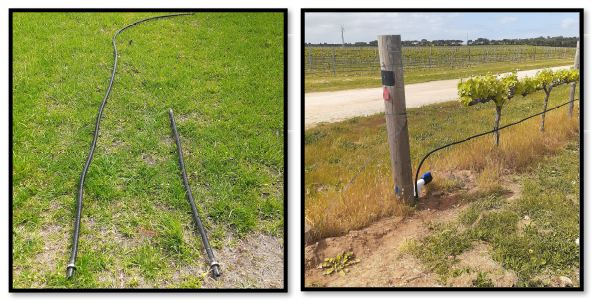
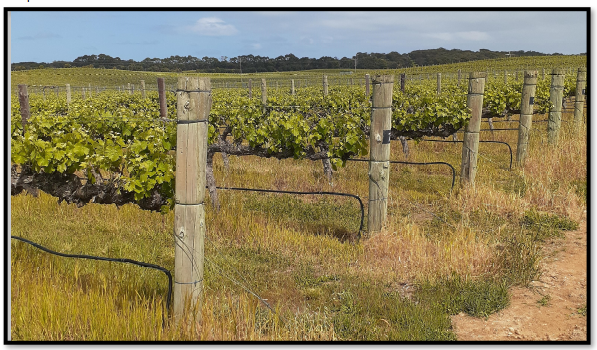
- New drip tube manufactured by Netafim Australia to allow more shifts to irrigate at the same time, and to improve pressure efficiencies drip rates and uniformity at the discharge drip point. These two variables also aid in reducing water wastage, and time says Lindsay, the Water Dynamics irrigation specialist working on the project.
- The new drip tube provides a more even water distribution, in-turn providing a more balanced growth to the vine canopy vigour, allowing for better grape protection and less stress during extreme heat.
- Also installed were collection/flushing manifolds to save on labour by reducing flushing points from 994 flush points to 84 flush points.
- Another requirement met by Water Dynamics was to have the connection risers for the drip tube laterals collection manifold that were flexible, crush resistant, and had to terminate 500mm above grade level. A riser of the correct length and crush resistance was fabricated for Water Dynamics by global micro-irrigation solutions innovator, Rivulis to meet this demand.
Industry and region experience
Lindsay says another huge intangible but real asset in upgrades such as this is irrigation experience in the region involved and the industry involved.
Experience in your area of business is a good general principle to observe across the spectrum of industries in which we operate, be they pastoral, livestock, horticultural, turf or any land use that may need to revisit its irrigation efficiencies over the years ahead.
Because, at the end of the day, you are not only buying a technology, but you are also investing in the knowledge of people to back it up. You need such people there through installation and commissioning, through service, and through replacement as this becomes optimal in the years ahead. Good technology needs good people to make it work best for you.
Don’t rely only on the claims of technology vendors. A smart move – particularly in an area of specialised needs such as viticulture – is to ask people making claims where they have worked before, what results they have achieved and what trends they see coming that particular vineyards in particular areas will need to respond to in the years ahead.
They should know their stuff. In reality, they have to know their stuff to help you, because the irrigation industry today is dealing with a seismic change of scenario with which all agricultural, viticultural and horticultural industries will have to deal in the years ahead.
For industries such as viticulture, change can be a great opportunity to be ahead of the game, to join industry leaders in achieving gains that will ensure their compatibility with national sustainability objects, while also helping to be robustly competitive.
For product and sales information, contact your local Water Dynamics branch
E: [email protected]
Latest Projects
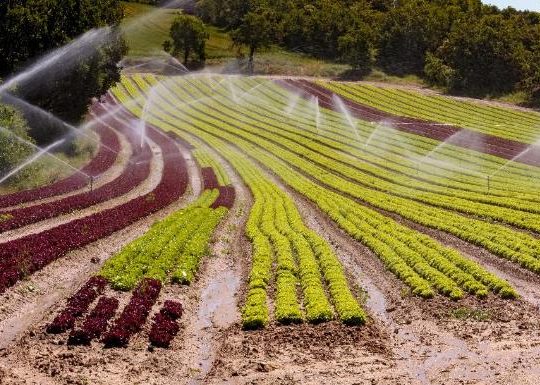
Early adopter of citrus growing automation achieves cost-efficiency, connectivity, and conservation in the one package
An Australian citrus grower at the forefront of automation efficiencies sweeping through the industry is increasing production quality and output…
Read More...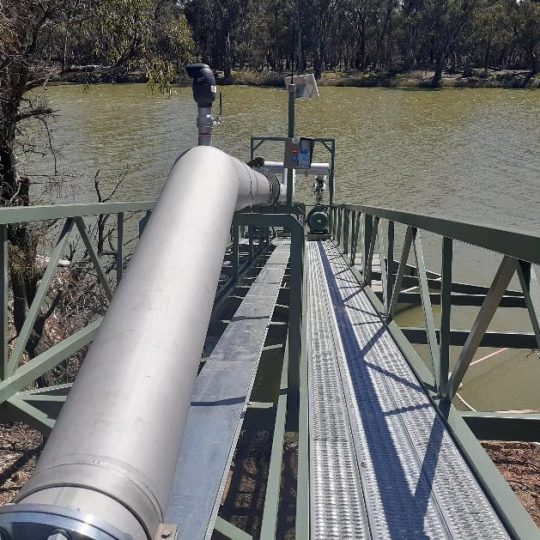
Premium table grape producer Palm Vineyards equips itself for a sustainable future with 3-into-1 irrigation upgrade
An international exporter of Australian table grapes noted for the quality of its fruit and sustainability of its horticultural practices,…
Read More...